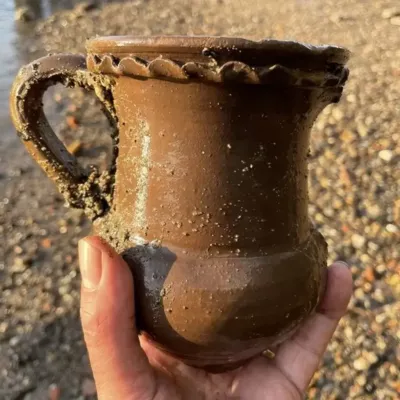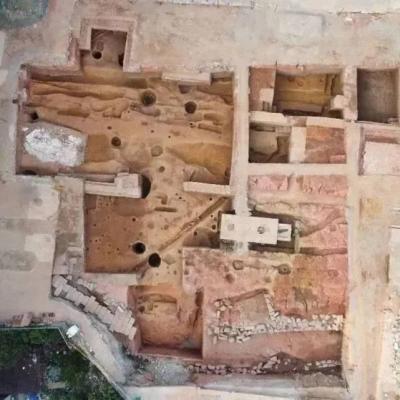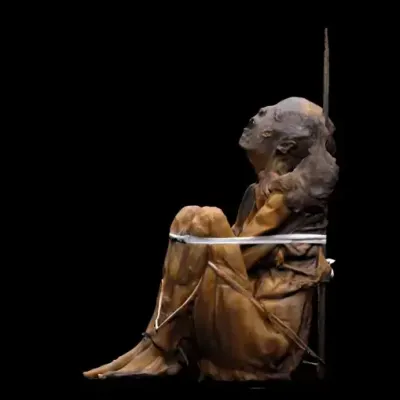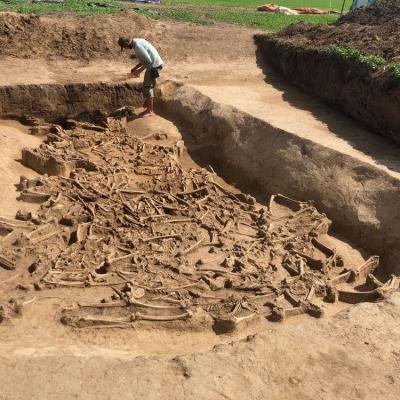INSTITUT SUPERIEUR D'ANTHROPOLOGIE
INSTITUTE OF ANTHROPOLOGY
ONLINE COURSES / COURS A DISTANCE
DEBUT COURS : AVRIL 2023
REGISTER NOW
ANGLETERRE –  Londres - A mudlarker says he has been told he has found a "rare" near-complete Roman cup from the banks of the River Thames. He said Museum of London archaeologists believed the object might date back to the 2nd Century AD. "They have discovered it is most likely a contemporaneous copy inspired by a much more expensive type of vessel made along the River Rhine in the 2nd Century AD. So it's kind of like a super bargain basement version of a vessel that was made then. "The museum said they hadn't identified another example that's ever been found in this state from mudlarking in London," he added. Mr Russell said experts believed there was "certainly a very good chance it would have been used for wine or another liquid".
Londres - A mudlarker says he has been told he has found a "rare" near-complete Roman cup from the banks of the River Thames. He said Museum of London archaeologists believed the object might date back to the 2nd Century AD. "They have discovered it is most likely a contemporaneous copy inspired by a much more expensive type of vessel made along the River Rhine in the 2nd Century AD. So it's kind of like a super bargain basement version of a vessel that was made then. "The museum said they hadn't identified another example that's ever been found in this state from mudlarking in London," he added. Mr Russell said experts believed there was "certainly a very good chance it would have been used for wine or another liquid".
https://www.bbc.com/news/uk-england-london-64468180
CHINE –  Guangzhou - Archaeologists have reason to think the city has been a central location for the country for more than 2,000 years. Recent construction on a hospital in Guangzhou led experts to more than 300 relics from six dynasties over a period of more than 2,000 years, according to the Institute of Archaeology at the Chinese Academy of Social Sciences. Among the ancient discoveries were several tombs, preserved infrastructure and smaller artifacts like tiles and pottery pieces. The oldest finds date to the Western Han dynasty — which lasted from 206 B.C. until 9 A.D., according to the Met Museum — and include drainage ditches connected to pottery pipes, water wells, an ash pit and three tombs, the institute said. Within the wells, the team said it discovered stone inkstone as well as several pottery pots. The ash pit contained remnants of tiles, pottery, boxes and tools. The three tombs were rectangular pits, archaeologists said. Each had funerary pottery, including bowls, boxes, pots with lids and cauldrons. Two of the tombs held decayed human remains, but the burial methods are unknown. A fourth tomb from the Southern dynasty — which lasted from 386 A.D. until 589 A.D. — was also discovered at the site. Unlike the Han tombs, the Southern tomb was a rectangular chamber tomb made of brick in which a body was buried upright. Inside the tomb, archaeologists said they found patterns in the bricks, a decayed human bone, three celadon cups and one porcelain bow. A second ash pit that was used starting in the Tang dynasty through the Five dynasties — 618 A.D. until 960 A.D. —was discovered and contained smooth shells, holding pots, incense burner covers, porcelain bowls and various kinds of tiles, the institute said. Archaeologists also found evidence of moats that existed sometime between 1368 and 1911, during the Ming and Qing dynasties, according to the institute.
Guangzhou - Archaeologists have reason to think the city has been a central location for the country for more than 2,000 years. Recent construction on a hospital in Guangzhou led experts to more than 300 relics from six dynasties over a period of more than 2,000 years, according to the Institute of Archaeology at the Chinese Academy of Social Sciences. Among the ancient discoveries were several tombs, preserved infrastructure and smaller artifacts like tiles and pottery pieces. The oldest finds date to the Western Han dynasty — which lasted from 206 B.C. until 9 A.D., according to the Met Museum — and include drainage ditches connected to pottery pipes, water wells, an ash pit and three tombs, the institute said. Within the wells, the team said it discovered stone inkstone as well as several pottery pots. The ash pit contained remnants of tiles, pottery, boxes and tools. The three tombs were rectangular pits, archaeologists said. Each had funerary pottery, including bowls, boxes, pots with lids and cauldrons. Two of the tombs held decayed human remains, but the burial methods are unknown. A fourth tomb from the Southern dynasty — which lasted from 386 A.D. until 589 A.D. — was also discovered at the site. Unlike the Han tombs, the Southern tomb was a rectangular chamber tomb made of brick in which a body was buried upright. Inside the tomb, archaeologists said they found patterns in the bricks, a decayed human bone, three celadon cups and one porcelain bow. A second ash pit that was used starting in the Tang dynasty through the Five dynasties — 618 A.D. until 960 A.D. —was discovered and contained smooth shells, holding pots, incense burner covers, porcelain bowls and various kinds of tiles, the institute said. Archaeologists also found evidence of moats that existed sometime between 1368 and 1911, during the Ming and Qing dynasties, according to the institute.
https://www.kansascity.com/news/nation-world/world/article271931282.html
INDE – Sarlichak - Two stone idols believed to be about 1,200 years old was found from a waterbody close to the ancient Nalanda University during desilting of a pond, an Archeological Survey of India official said. The idols were found earlier this week from Tarsinh pond at Sarlichak village near the ancient Nalanda Mahavira, a world heritage site about 88 km from here. Details of the two idols were, however, not divulged either by Archeological Survey of India or the administration.
https://www.ndtv.com/india-news/1-200-year-old-idols-found-in-nalanda-archeological-body-seeks-possession-3749438
CHINE -Hebosuo - More than 10,000 bamboo scripts, among which about 1,300 with written characters, and 837 seal impressions dating back to the Han Dynasty (202 BC-220 AD) have been found in Yunnan Province, southwest China, said the provincial cultural relics and archaeology institute. This new discovery indicates that the central government of the Western Han Dynasty (202 BC-25 AD) exercised its administrative power over the Yunnan region at that time, serving as important physical evidence for the forming and development of a unified multi-ethnic China. The artifacts were uncovered in Hebosuo site, Jinning District of Kunming, capital of Yunnan, a core residential area of the ancient Yunnan region. Notably, most of the seal impressions unearthed at the site had official seals, with Chinese characters covering the names of 20 out of the 24 counties administered by the ancient Yunnan region, said the institute. According to historical documents, the Han Dynasty ruled over the Yunnan region as early as 109 BC and the ancient Yunnan kingdom has since become part of the multi-ethnic China. Currently, archaeologists are still trying to discover the location of the capital of ancient Yunnan, which is believed to near the Hebosuo site.
http://english.anhuinews.com/newscenter/e/202302/t20230203_6652876.html
ITALIE –  Rome - A life-sized statue of a Roman emperor has been discovered during sewer repair works near the Appia Antica, ancient Rome's first highway. The figurine bears a “fair resemblance” to Emperor Decius, who ruled Rome from 249 to 251 AD, according to archaeologist Francesca Romana Paolillo. It shows frown lines on the forehead that is typical of depictions of emperors from the 3rd century, a time of deep crisis for the Roman Empire. The statue is considered “quite rare” due to the portrayal of a Roman leader as Hercules.
Rome - A life-sized statue of a Roman emperor has been discovered during sewer repair works near the Appia Antica, ancient Rome's first highway. The figurine bears a “fair resemblance” to Emperor Decius, who ruled Rome from 249 to 251 AD, according to archaeologist Francesca Romana Paolillo. It shows frown lines on the forehead that is typical of depictions of emperors from the 3rd century, a time of deep crisis for the Roman Empire. The statue is considered “quite rare” due to the portrayal of a Roman leader as Hercules.
https://tvpworld.com/66025619/italy-statue-of-roman-emperor-uncovered-during-sewer-repairs
PORTUGAL – 
 Sado - After they revisited photos of ancient human skeletons first exhumed in Portugal’s Sado Valley in the 1960s, archaeologists now believe that the 8,000-year-old remains went through a mummification practice before their burial. This would make the remains the oldest evidence for Mesolithic mummification in Europe. In fact, it could very well be the earliest evidence of mummification in the world. Excavations in the Sado Valley in southern Portugal, at the sites of Arapouco and Poças de S. Bento, between 1958 and 1964 recovered more than 100 skeletons dating between 8,000 and 7,000 years ago. Unfortunately, much of the original documentation for these extraordinary finds was lost, including photographs, site plans, and field drawings. These verified photos depict 13 bodies exhumed in 1961 and 1962, which Cardoso and colleagues used to reconstruct their likely burial positions using an archaeothanatological analysis. Based on knowledge of natural decay processes, this method has made it possible to reconstruct in detail how humans have historically dealt with their dead. In addition to observations about the spatial distribution of the ancient bones from Sado Valley, forensic anthropologist Hayley Mickleburgh performed decomposition experiments to predict how human corpses pin different burial positions could look like if they had been mummified or not. Together, these observations suggest that some of these remains must have been mummified. Although there was no soft tissue left, the archaeologists reached this conclusion based on deductions from indirect evidence like the position of the bodies, with their knees bent and pressed against the chest, as well as the presence of sediment infill around the bones and the absence of disarticulation. An unprepared decomposing corpse will disarticulate at weak joints relatively quickly after its burial, but mummified bodies still preserve articulation. The authors of the new study believe that before being buried, the desiccating bodies were gradually tightened with ropes, binding the limbs in place and compressing the remains into the desired position. This would explain some of the signs of mummification, which was likely performed to ease transport to the grave and to preserve the shape of the body in life after burial.
Sado - After they revisited photos of ancient human skeletons first exhumed in Portugal’s Sado Valley in the 1960s, archaeologists now believe that the 8,000-year-old remains went through a mummification practice before their burial. This would make the remains the oldest evidence for Mesolithic mummification in Europe. In fact, it could very well be the earliest evidence of mummification in the world. Excavations in the Sado Valley in southern Portugal, at the sites of Arapouco and Poças de S. Bento, between 1958 and 1964 recovered more than 100 skeletons dating between 8,000 and 7,000 years ago. Unfortunately, much of the original documentation for these extraordinary finds was lost, including photographs, site plans, and field drawings. These verified photos depict 13 bodies exhumed in 1961 and 1962, which Cardoso and colleagues used to reconstruct their likely burial positions using an archaeothanatological analysis. Based on knowledge of natural decay processes, this method has made it possible to reconstruct in detail how humans have historically dealt with their dead. In addition to observations about the spatial distribution of the ancient bones from Sado Valley, forensic anthropologist Hayley Mickleburgh performed decomposition experiments to predict how human corpses pin different burial positions could look like if they had been mummified or not. Together, these observations suggest that some of these remains must have been mummified. Although there was no soft tissue left, the archaeologists reached this conclusion based on deductions from indirect evidence like the position of the bodies, with their knees bent and pressed against the chest, as well as the presence of sediment infill around the bones and the absence of disarticulation. An unprepared decomposing corpse will disarticulate at weak joints relatively quickly after its burial, but mummified bodies still preserve articulation. The authors of the new study believe that before being buried, the desiccating bodies were gradually tightened with ropes, binding the limbs in place and compressing the remains into the desired position. This would explain some of the signs of mummification, which was likely performed to ease transport to the grave and to preserve the shape of the body in life after burial.
https://www.zmescience.com/science/news-science/oldest-mummies-portugal-0432432/
FRANCE –  Nemausus - Dès le Ve s. av. J.-C., ce secteur sud est occupé par une campagne viticole. L’agglomération est protégée à cet endroit par un simple fossé défensif qui pourrait traverser la parcelle fouillée. Dans la première moitié du IIe s. av. J.-C., cet espace périurbain est réorganisé avec la création d’un nouveau réseau viaire dont l’un des axes pourrait constituer un tronçon de la voie Domitiennne. Celle-ci organise dès lors le nouveau parcellaire. Après la conquête de la région par Rome, des faubourgs occupent progressivement ce secteur, ils accueillent des activités artisanales, et notamment plusieurs unités de forges. Sous le règne de l’empereur Auguste, une nouvelle enceinte, enserre Nîmes sur une superficie de 220 ha. Ainsi, l’emprise de la fouille se situe au cœur du secteur intra-muros de l’agglomération antique. Le quartier, loti à un rythme conséquent, devient un espace dynamique, bordé par la voie Domitienne qui structure la ville depuis sa construction. La moitié nord de la parcelle fouillée est occupée par les aménagements d’une domus dont le plan est centré autour d’une probable cour. La plupart des pièces présentent des sols en béton et des enduits peints sur les murs. La salle la plus à l’est de cette domus montre un sol mosaïqué polychrome à décors géométriques. Plus au sud, cette maison est aussi équipée d’une salle chauffée et d’un puits, probablement situé dans un espace ouvert attenant. Ces vestiges sont toutefois moins lisibles en raison de leur détérioration. La fin de l’occupation de cet îlot semble marquée par un incendie généralisé. Des effondrements de constructions brûlées ont été découverts sur l’ensemble du terrain, de manière évidente dans le sud de la parcelle et aussi sur les sols en béton de la domus. Cet incendie a permis de conserver l’architecture des bâtiments antiques, constituée à 90 % de terre crue, sous forme de briques ou de terre massive (technique de construction en terre banchée avec tassement entre deux planches). Les constructions en pierres ne deviendront majoritaires qu’au Moyen-Age. Après le IIIe s., les terrains sont remis progressivement en culture, l’ancien paysage urbain se transformant en zone de campagne mêlant friches et cultures.
Nemausus - Dès le Ve s. av. J.-C., ce secteur sud est occupé par une campagne viticole. L’agglomération est protégée à cet endroit par un simple fossé défensif qui pourrait traverser la parcelle fouillée. Dans la première moitié du IIe s. av. J.-C., cet espace périurbain est réorganisé avec la création d’un nouveau réseau viaire dont l’un des axes pourrait constituer un tronçon de la voie Domitiennne. Celle-ci organise dès lors le nouveau parcellaire. Après la conquête de la région par Rome, des faubourgs occupent progressivement ce secteur, ils accueillent des activités artisanales, et notamment plusieurs unités de forges. Sous le règne de l’empereur Auguste, une nouvelle enceinte, enserre Nîmes sur une superficie de 220 ha. Ainsi, l’emprise de la fouille se situe au cœur du secteur intra-muros de l’agglomération antique. Le quartier, loti à un rythme conséquent, devient un espace dynamique, bordé par la voie Domitienne qui structure la ville depuis sa construction. La moitié nord de la parcelle fouillée est occupée par les aménagements d’une domus dont le plan est centré autour d’une probable cour. La plupart des pièces présentent des sols en béton et des enduits peints sur les murs. La salle la plus à l’est de cette domus montre un sol mosaïqué polychrome à décors géométriques. Plus au sud, cette maison est aussi équipée d’une salle chauffée et d’un puits, probablement situé dans un espace ouvert attenant. Ces vestiges sont toutefois moins lisibles en raison de leur détérioration. La fin de l’occupation de cet îlot semble marquée par un incendie généralisé. Des effondrements de constructions brûlées ont été découverts sur l’ensemble du terrain, de manière évidente dans le sud de la parcelle et aussi sur les sols en béton de la domus. Cet incendie a permis de conserver l’architecture des bâtiments antiques, constituée à 90 % de terre crue, sous forme de briques ou de terre massive (technique de construction en terre banchée avec tassement entre deux planches). Les constructions en pierres ne deviendront majoritaires qu’au Moyen-Age. Après le IIIe s., les terrains sont remis progressivement en culture, l’ancien paysage urbain se transformant en zone de campagne mêlant friches et cultures.
https://www.inrap.fr/un-quartier-de-nemausus-entre-ville-gauloise-et-ville-romaine-gard-17050
SLOVAQUIE –  Vráble - Fouillé depuis 2010 situé dans la ville de Nitra, le site de Vráble, dans l'ouest de la Slovaquie, abritait l’une des plus grandes colonies du Néolithique en Europe centrale. Jusqu’à présent considéré comme un paisible établissement constitué dans sa plus grande extension de trois villages rapprochés, le visage de Vráble a soudain pris une autre tournure en 2022, après que les archéologues ont fait à deux reprises une bien macabre découverte : des squelettes sans tête, quelques-uns tout d’abord, puis une trentaine. Le traitement réservé à ces corps humains était parfaitement inattendu dans ce contexte, et les chercheurs ne peuvent à présent que s’interroger sur les raisons de cette apparente brutalité, qui remet en question l’image qu’ils s’étaient forgée du lieu. Les voici donc contraints de changer de perspective et de repenser le site dans le contexte des accès de violence qui ont marqué la période néolithique. Localisé à une centaine de kilomètres à l'est de Bratislava, le site de Vráble fut occupé entre 5250 et 4950 avant notre ère, soit au début du Néolithique. Il relève de la culture rubanée, comme le montrent les céramiques décorées de bandes constituées de plusieurs lignes qui y ont été mises au jour. Grâce à des analyses géomagnétiques, les archéologues y ont identifié plus de 300 maisons réparties dans trois habitats distincts.
Vráble - Fouillé depuis 2010 situé dans la ville de Nitra, le site de Vráble, dans l'ouest de la Slovaquie, abritait l’une des plus grandes colonies du Néolithique en Europe centrale. Jusqu’à présent considéré comme un paisible établissement constitué dans sa plus grande extension de trois villages rapprochés, le visage de Vráble a soudain pris une autre tournure en 2022, après que les archéologues ont fait à deux reprises une bien macabre découverte : des squelettes sans tête, quelques-uns tout d’abord, puis une trentaine. Le traitement réservé à ces corps humains était parfaitement inattendu dans ce contexte, et les chercheurs ne peuvent à présent que s’interroger sur les raisons de cette apparente brutalité, qui remet en question l’image qu’ils s’étaient forgée du lieu. Les voici donc contraints de changer de perspective et de repenser le site dans le contexte des accès de violence qui ont marqué la période néolithique. Localisé à une centaine de kilomètres à l'est de Bratislava, le site de Vráble fut occupé entre 5250 et 4950 avant notre ère, soit au début du Néolithique. Il relève de la culture rubanée, comme le montrent les céramiques décorées de bandes constituées de plusieurs lignes qui y ont été mises au jour. Grâce à des analyses géomagnétiques, les archéologues y ont identifié plus de 300 maisons réparties dans trois habitats distincts.
https://www.sciencesetavenir.fr/archeo-paleo/archeologie/des-dizaines-de-corps-sans-tete-decouverts-sur-le-site-neolithique-de-vrable-en-slovaquie_169209
INDE – Kondagaon - Gold coins belonging to the 12th century were found during earth-digging for a road construction in Chhattisgarh’s Kondagaon district, officials said on Saturday.A pot containing 57 gold coins, a silver coin and a gold earring was unearthed. As per the preliminary investigation, the coins date back to the 12th and 13th century. The inscriptions on the coins are in a script which was prevalent during the time of Yadav dynasty which ruled over Vidarbha.
https://www.hindustantimes.com/india-news/yadav-era-gold-coins-from-12th-century-found-in-chhattisgarh-says-official/story-sqjNE5Z4WJY1eIBfz3j1uK.html